Boom-Boom Kaboom!
Welcome to this week’s Magic Market, best friend to any adventurer who looks to confound his enemies with new and exciting items! I’m Marie, one of the new Necromancers of the Northwest and I will be your host today as we look at gear crafted and used by reckless goblins. Anyone looking to get a little bang for their buck is sure to have a lot of fun with the following items. So, without further ado, let’s have a look at what the little critters have to show us.
Bombardier’s Jacket
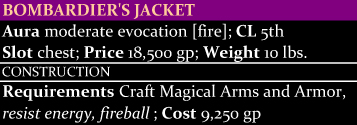
Meant for the somewhat insane, the bombardier’s jacket allows the wearer to deal a lot of damage at the expense of his own well-being. This coat smells burnt and looks singed in certain places. Small, fire-emitting bombs stud the outside of the jacket and occasionally let out puffs of smoke.
This masterwork studded leather armor is fashioned into a coat that grants the wearer fire resistance 10 (this resistance does not stack with fire resistance gained from other sources). In addition to this, the wearer can activate the coat to turn himself into a living explosive. Three times per day, as a standard action, the wearer can activate the coat’s explosive magic, causing the bombs on the jacket to erupt. This explosion deals 5d6 points of fire damage to each creature adjacent to the wearer, as well as to the wearer himself. Creatures other than the wearer who are caught in the blast may make a Reflex save (DC 17) to halve the damage. The wearer is not only unable to make a Reflex save to halve this damage, but he does not gain the benefits of the coat’s fire resistance for the purpose of this explosion. The explosion from an activated bombardier’s jacket sets fire to combustibles, and damages objects in the area of the blast. The jacket cannot be activated unless worn.
Contagion Grenade
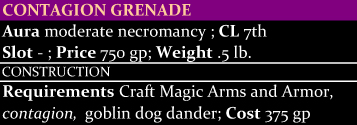
This “grenade” is an attempt goblins have made to replicate the plague bomb invented by alchemists of more developed races. The contents of the grenade are encased in a sack, typically made of goblin dog hide, which causes non-goblinoid creatures itching discomfort when touched. Inside the bag is a substance that forms a smoke cloud when exposed to air.
The grenade has a range increment of 15 feet, and bursts upon impact, releasing a dense smoke cloud that fills a 5-foot-radius area. The cloud spreads, increasing the radius by 5 feet per round, but dissipates completely after 3 rounds (a strong gust of wind can dissipate the cloud in 1 round). Non-goblinoids who come in contact with the cloud immediately become afflicted with the itching rash associated with coming into contact with a goblin dog: such creatures must make a DC 16 Fortitude save or break out in an itching rash. A creature affected by this rash suffers a –2 penalty to Dexterity and Charisma for 1 day (multiple allergic reactions do not stack). Remove disease or similarly powerful magic removes the rash instantly. This is a disease effect.
Goblin Boom Arrow
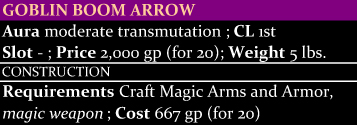
The shafts of these temperamental arrows contain small, impact-triggered bombs. The glass and metal shrapnel can be heard inside if shaken very gently.
Goblin boom arrows are a simple concept, first created by raiding goblins to soften up their opponents before engaging in melee combat. On impact, the arrows explode, inflicting 2d6 points of piercing and slashing damage to the target, and 1d6 points of piercing and slashing damage to all creatures adjacent to the target. In addition to this damage, all affected creatures must make a DC 16 Reflex save or be blinded by the shrapnel. This blindness can be cured with a successful Heal check (DC 15); doing so is a full-round action that provokes attacks of opportunity.
Goblin boom arrows can deal precision-based damage to the primary target (such as with the rogue’s sneak attack class feature), but not to any of the adjacent creatures. Additionally, these arrows are slightly heavier than usual, and reduce the range increment of the bow used to shoot them by 20 feet.
Horsebane Whistle
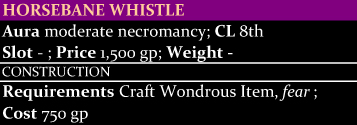
Goblins’ everlasting disdain for horses has led them to fashion a means with which to torment these beasts of burden for sport. These whistles are crudely carved from bone into the shape of a screaming horse head, and emit a growling, predatory sound when blown into.
The sound from this whistle can be heard clearly 100 feet away with a DC 5 Perception check; the DC increases by 5 for every 50 feet beyond that. When blown, horses (and other domesticated beasts of burden, such as donkeys and oxen) that hear the sound must succeed on a Will save (DC 15) or be panicked for 1 minute. Even if the horse succeeds on this save, it is still shaken for 1d4 rounds. Regardless of whether or not it succeeds its saving throw, the creature cannot be affected again by a horsebane whistle for one hour.
Ruckus Bomb
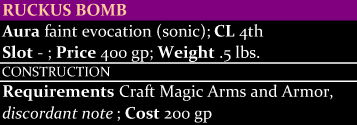
These explosives were originally designed as a diversionary tool, but also have some combat purposes. They are usually brightly colored and emit a faint giggling noise when held. Explosions from these grenades generate a cacophony of magical laughter and can have a devastating effect on those too close to the blast.
Ruckus bombs (or “giggling grenades,” as pranksters like to call them) have a range increment of 30 feet and are treated as thrown splash weapons. Creatures within 10 feet of the explosion take 4d6 points of sonic damage and are deafened for 1 minute. Creatures between 10 feet and 20 feet from the explosion are subject only to the sonic damage created by the blast. Creates more than 20 feet from the explosion are not affected. A successful Fortitude save (DC 18) halves the sonic damage and negates the deafness (if applicable). The noise from these grenades can be easily heard up to 300 feet away from the blast zone, and sound like a rowdy group of cackling goblins.


